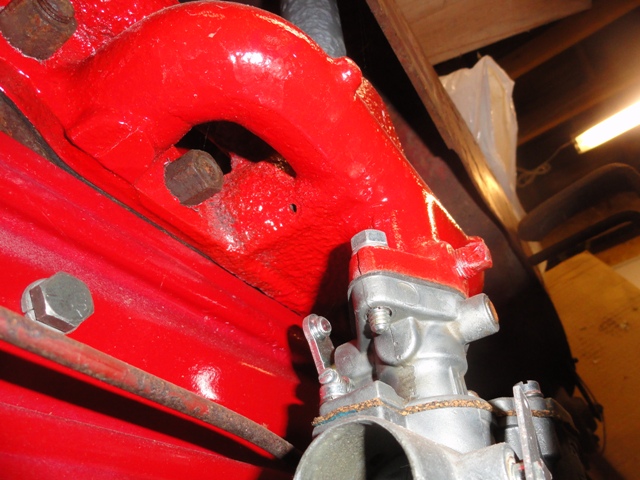Page 1 of 1
Exhaust question
Posted: Thu Nov 15, 2012 7:52 pm
by rexxon
While working on my Cub today getting ready for winterization. I have heard an exhaust noise for sometime, sounded like the clamp for the underslung exhaust was not sealing correct. Well after doing some carb work today i started the Cub while sitting on my stool next to it.
I have been fooling with these tractors off and on for over 40 years and never noticed until today the small hole in the exhaust manifold that points forward to direct warm air onto the breather pipe. The reason is clear.
Its not a crack or anything like that its an obvious factory hole. Were all Cubs from 47 onward built with the hole?????????
Re: Exhaust question
Posted: Thu Nov 15, 2012 8:03 pm
by GWrider1957
Never noticed. I'll check mine in the morning.
Re: Exhaust question
Posted: Thu Nov 15, 2012 8:08 pm
by Rick Spivey
Pretty sure they all have it, it is actually a drain hole for any water or condensate that finds it's way into the manifold.
Re: Exhaust question
Posted: Thu Nov 15, 2012 9:33 pm
by challenger
As Rick said it is there to drain the condensate out of the exhaust system. Any one who has started the Cub on a cool, damp morning knows that this tractor fogs and spits quite a bit before she warms up. If you shut her down before she is warmed up, that condensate is better outside than sitting inside the exhaust manifold. The crankcase is also prone to build up condensate, especially with short operating times. It is evident by the milky gunk that forms on the dip stick inside the breather tube.
Re: Exhaust question
Posted: Thu Nov 15, 2012 10:12 pm
by John *.?-!.* cub owner
A lot of them are plugged by rust, but I have never seen a manifold without the hole.
Re: Exhaust question
Posted: Fri Nov 16, 2012 7:42 am
by Denny Clayton
John *.?-!.* cub owner wrote:A lot of them are plugged by rust, but I have never seen a manifold without the hole.
Agreed. I've seen a lot of them that
looked like there was no hole, but if you dig around it'll show up.

Re: Exhaust question
Posted: Fri Nov 16, 2012 8:36 am
by Scrivet
This subject seems to be answered but with no pictures; so here's an old thread with pictures.
http://www.farmallcub.com/phpBB2/viewtopic.php?f=1&t=56308
Re: Exhaust question
Posted: Fri Nov 16, 2012 6:02 pm
by rexxon
O.K. But they made it so it is pointing a little forward, just enough to hit the metal tube part of the air breather.
Wonder if that was done on purpose to drain water off the manifold but also to warm the front of the carb in cold weather to help stop venture effect. Thoughts????????????????????
Re: Exhaust question
Posted: Fri Nov 16, 2012 6:24 pm
by Barnyard
I doubt it would heat any air enough to make any difference going into the carb.

Re: Exhaust question
Posted: Fri Nov 16, 2012 9:04 pm
by Winfield Dave
Barnyard wrote:I doubt it would heat any air enough to make any difference going into the carb.

Anyone who has been around a Cub knows the amount of air the fan pushes back past the engine...the air coming from that hole is blown away before it goes anywhere.
Re: Exhaust question
Posted: Sat Nov 17, 2012 6:12 am
by rexxon
I suppose I just have not spent enough time around them to know everything, that is kind of why I asked the question. However I do find it odd that on my 140 and 240 the holes are in the manifold so that also drain in the area onto the carb throat.
Re: Exhaust question
Posted: Sat Nov 17, 2012 7:11 am
by rexxon
I went back in my memory banks, and one time years ago I had a Farmall H and was using during a blizzard to move snow.
She quit while I was moving from one location to another. I called my friend who has since passed away, he worked for years at the local IH dealership in town back when we had weather that was colder than now 1950-1965. He fooled with it some and told me she was iced up, he was looking at the frost on the intake manifold near the carb throat.
He said"if I remember correct" that it was a problem that they cured by adapting the heat shield off of a distilate manifold to keep heat onto the areas prone to icing.

